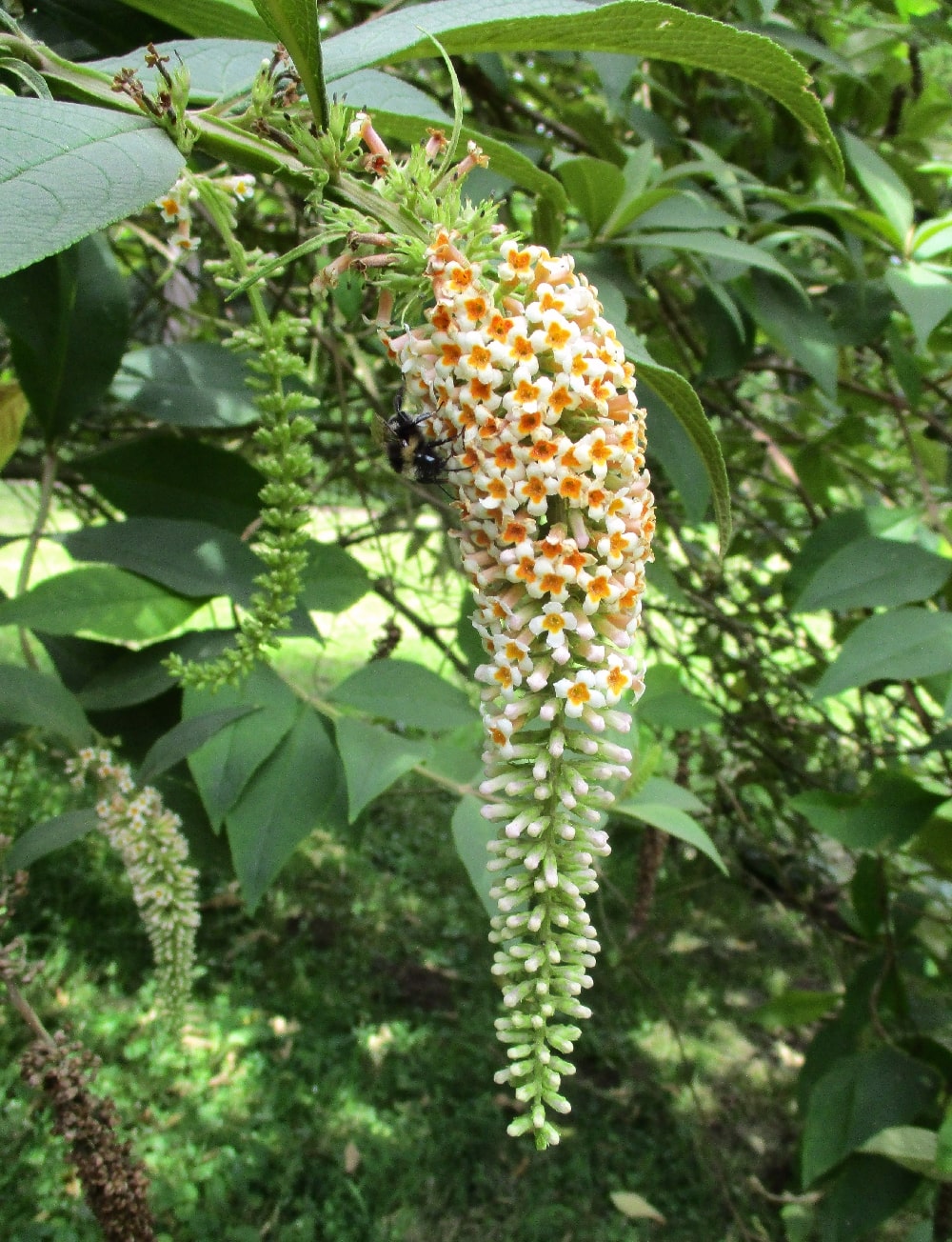
Buddleja forrestii and
Buddleja macrostachya
Updated July 2022
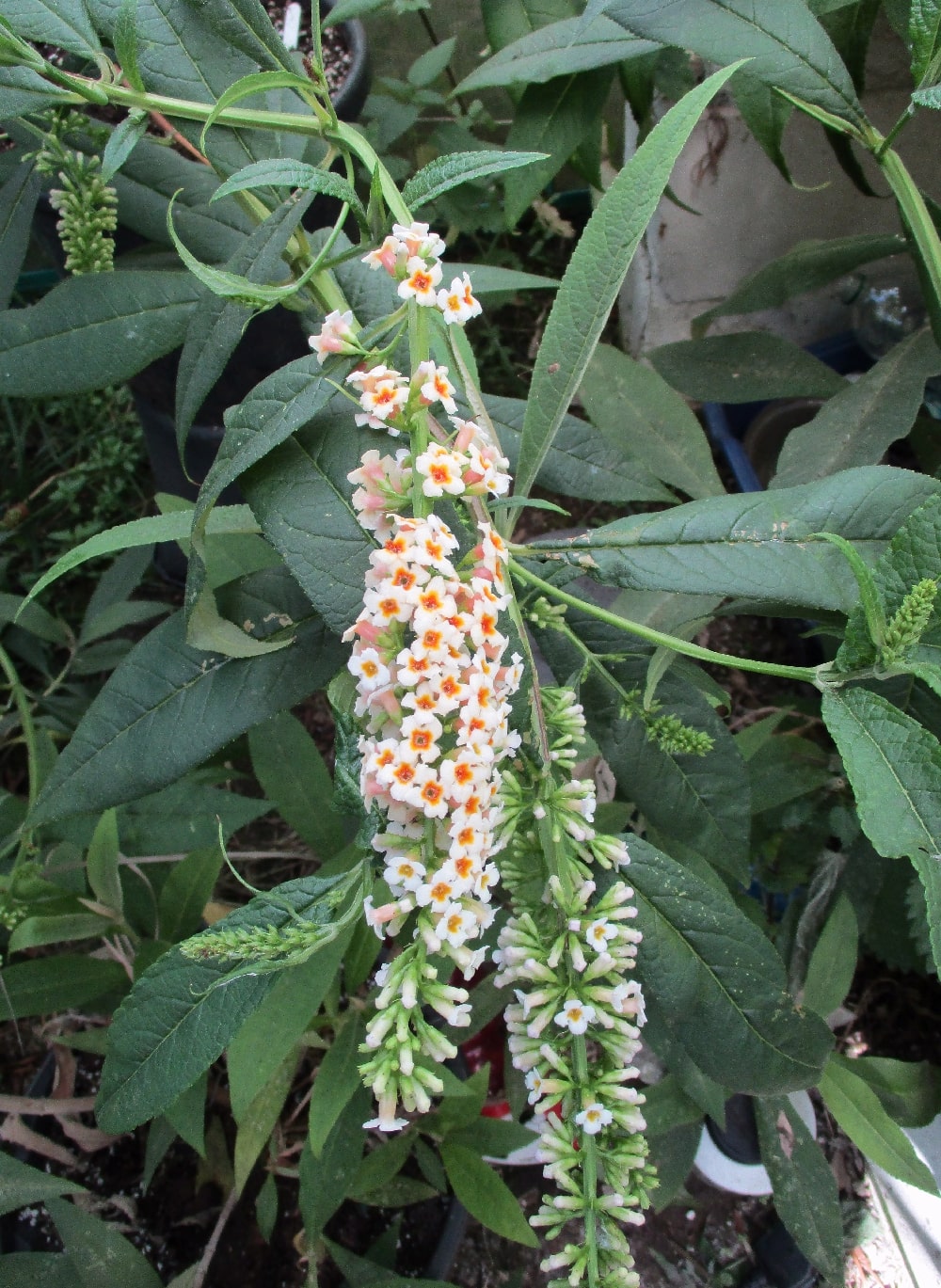
This plant of unknown origin was labelled B. macrostachya, looking very like that species. On closer examination, it turned out to be B. forrestii.
Open full size image in a new window
B. forrestii and B.macrostachya are two closely allied Himalayan species with a significant overlap in range. They both originate from south-western China (notably Yunnan and Sichuan), Bhutan, northern Myanmar, and north-east India, with B. macrostachya ranging further south and east into Bangladesh, Thailand and northern Vietnam. Members of these two different species can appear very similar to one another and are easily confused, having similar forms, foliage and flowers. Generally, both grow as large woody shrubs as hillside scrub and in forest clearings, and are usually found at altitudes greater than 1,000 metres. Evolving for a montane habitat makes them more able to cope with adverse weather conditions than one might expect. Different collections vary in their hardiness, but mostly they would be able to withstand an average winter in lowland southern England (USDA zone 8), perhaps requiring extra shelter further north.
The taxonomy of these species is not without controversy. The famous plant hunters, such George Forrest and Francis Kingdon-Ward, sent numerous specimens from the Himalayan region back to UK botanical institutions (especially the Royal Botanic Gardens, Edinburgh) in the early 20th century. This was era of ‘splitting’ plants into separate species based on very small variations, and as a result a large number of ‘new’ species were described. Later examination of both the dried herbarium specimens and those in living collections realised that many could be ‘lumped’ into just two species. Therefore, the last systematic review of the old world Buddleja (see Leeuwenberg 1979) sunk a number of species into B. forrestii and B.macrostachya, reducing many former species to synonyms of these two species.
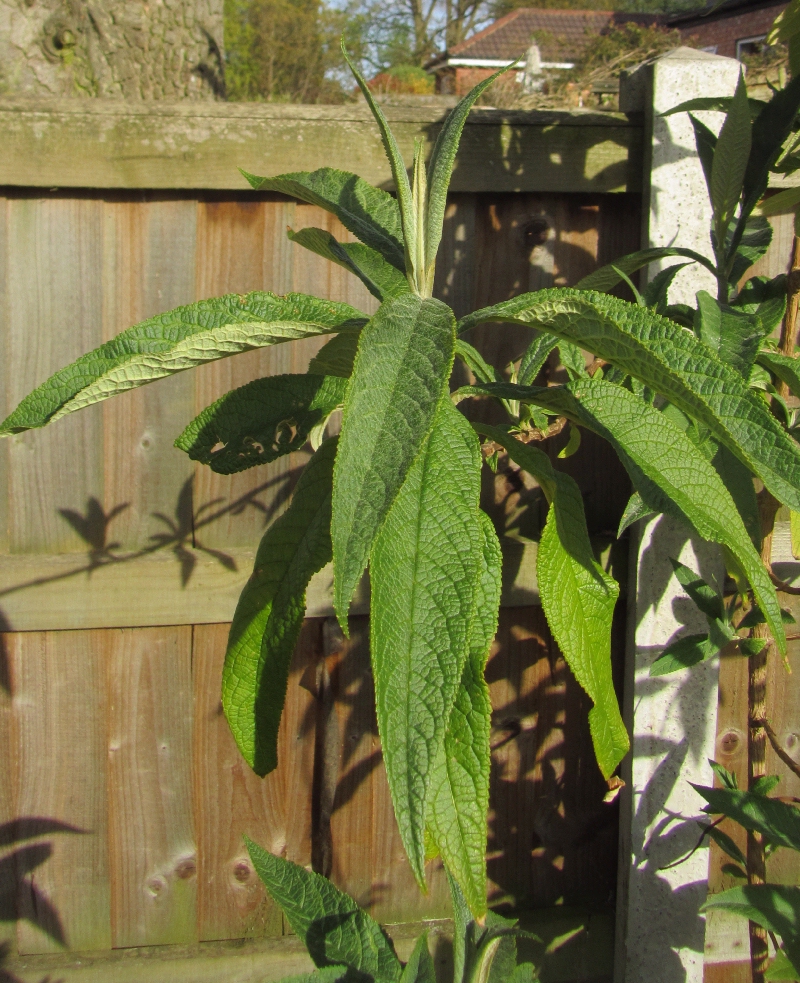
The two species share similar foliage, large leaf blades, which are lanceolate to elliptic in shape with an acuminate (pointed) apex. This is a B. forrestii.
Open full size image in a new window
From my experience of growing several different forms of each species, being able to closely examine the plants, and the results of several crossing experiments, I would agree with Leeuwenberg: there is little justification for dividing either species-group into a greater number. Two specimens that may appear rather different can share significantly more similarity on closer examination.
It can be confusing though: two specimens from different species may be superficially more similar to one another than to members of their own species. The tendency to self-fertility and the opposite propensity for hybridisation, and hence the possibility of plants intermediate between the two species, complicate matters still further. However, I hope to show below that this can be untangled and the species can be reliably distinguished.
Their horticultural merit may be somewhat debatable, requiring space and tending to a rangy habit. However, these two species offer the gardener something more exotic than the familiar cultivars, whilst being only a little more challenging to grow. The requirements of these species are not dissimilar: full sun is best, but because they evolved at altitude they don’t like to be too hot; they need a humus-rich soil which is moisture retentive in summer and well-drained in winter, and they're not fussy about pH. Shelter them from the harshest winds and avoid planting in frost pockets. The roots will benefit from a winter mulch which protects the soil from freezing solid. Plants may be killed almost to the ground in really harsh weather, but will regenerate from the hardwood if the root-ball is kept alive.
Buddleja forrestii Diels
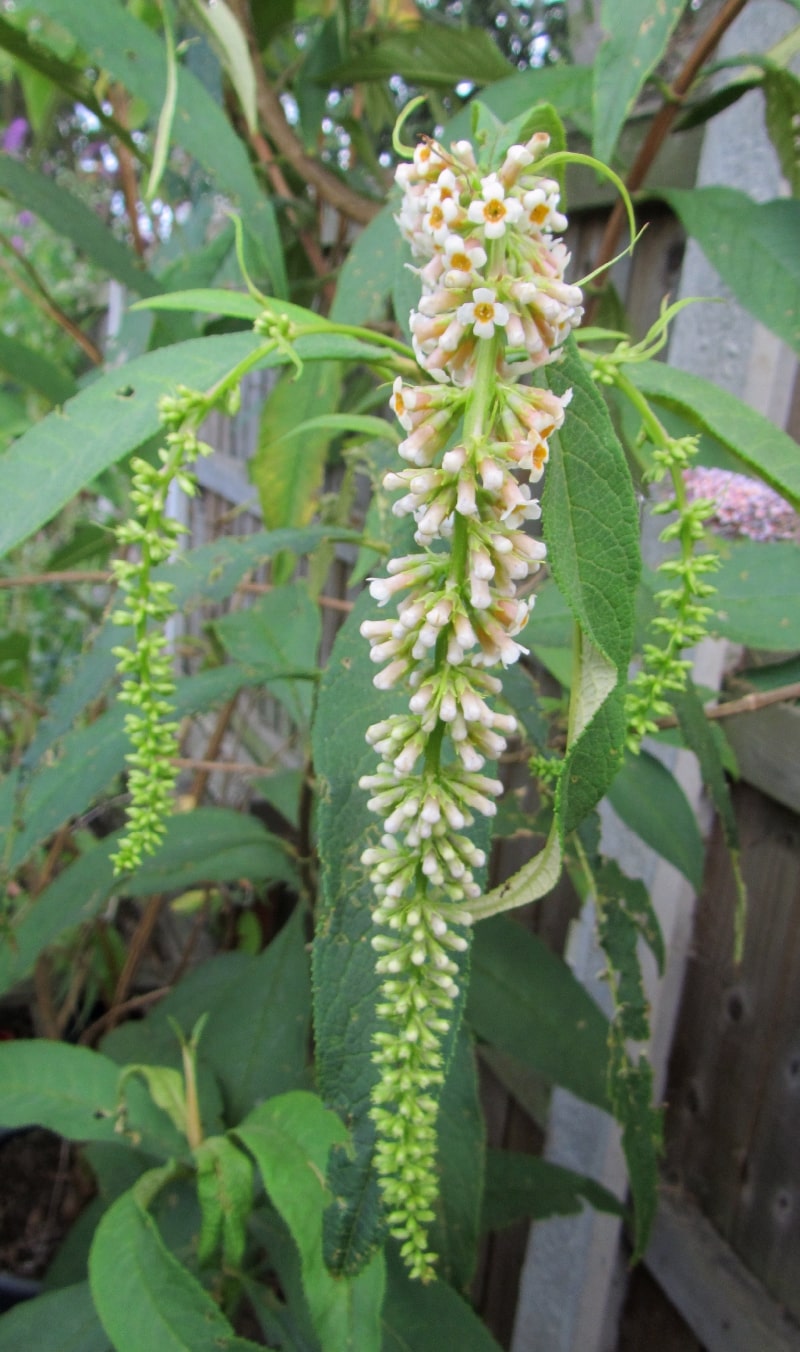
The long flower panicle of a B.
forrestii. This plant's native origin is unknown.
Open full size image in a new window
Synonymous species:
Buddleja cooperi W.W.Smith; Buddleja forrestii var.
gracilis Lingelsheim; Buddleja henryi Rehder & E.H.Wilson; Buddleja henryi var. glabrescens C.Marquand;
Buddleja latiflora S.Y.Pao; Buddleja limitanea W.W.Smith; Buddleja longifolia Gagnepain; Buddleja pterocaulis
A.B.Jackson; Buddleja subherbacea Keenan; Buddleja
taliensis W.W.Smith.
B. forrestii is a highly variable Himalayan species and is closely allied with B. macrostachya. There are quite a few individual cultivars (or collections) around the UK in various botanical gardens and plant collections. Sometimes their origins have been lost or forgotten, and in some instances even labelled as an entirely different species.
The plant shown is from Roseland House Garden and Nursery in Cornwall, and I’ve tracked it back to Forde Abbey in Dorset. Beyond that, the trail goes cold. It has many typical features of the species, such as large robust leaves and four-angled winged branchlets. The inflorescences, which appear in July and August, are long and pendulous. The flowers are just off-white, sometimes with a pinkish cast, emerging from mauve-flushed buds.
I’ve found it to be reasonably hardy, down to at least -10ºC, and these large species Buddleja do become more hardy with size and age. It’s semi-evergreen; although the foliage suffers in the cold, and it may even be killed back to the old wood in very harsh winters; it should still survive, producing strong new growth as the spring warms up. Already about 3 metres in height and spread after just a few years, I expect to get bigger, maybe even reaching the proportions of a small tree.
The plant shown at the top of the page, which came to me labelled up as B. macrostachya, is quite similar, except overall it’s smaller and fully deciduous most winters.
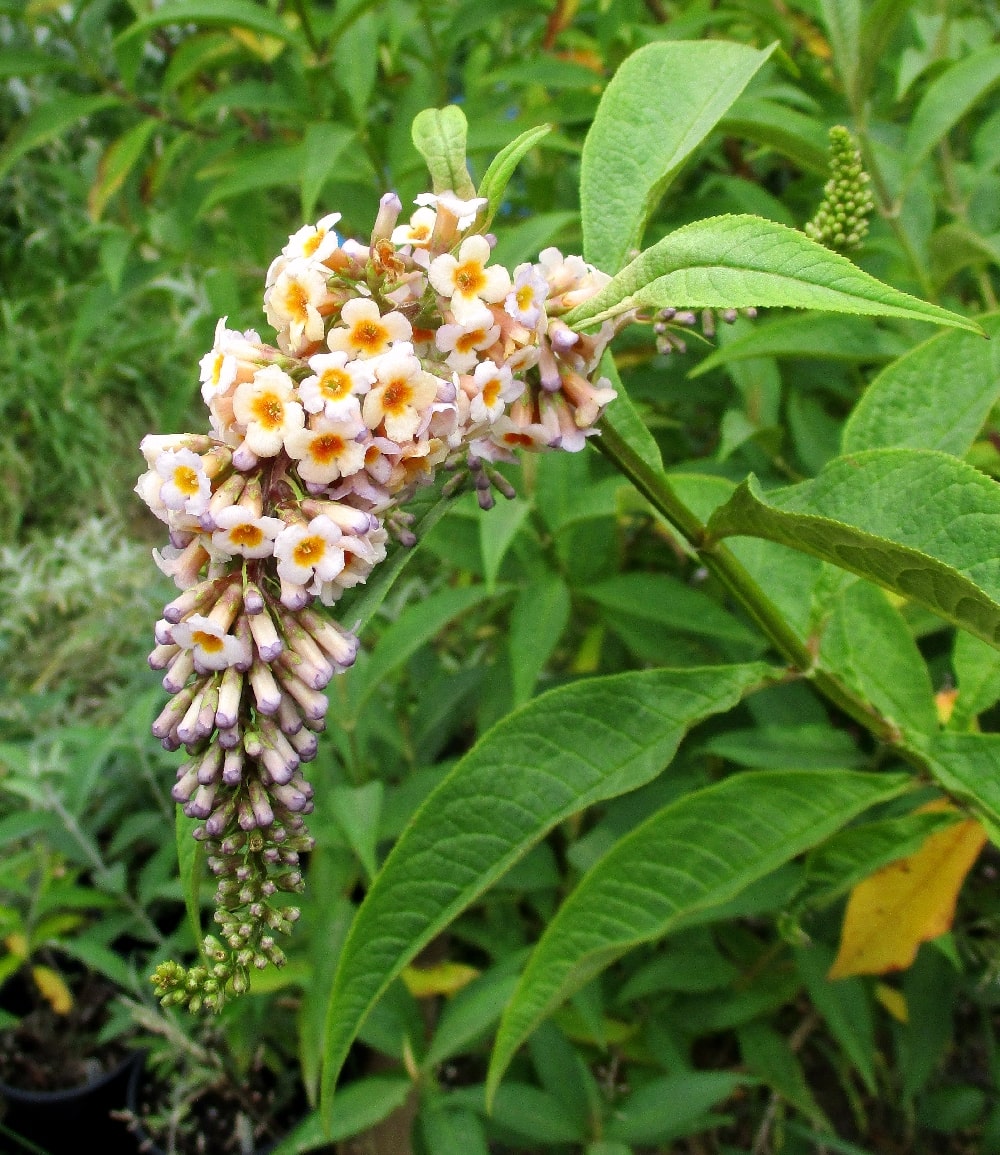
W/O 7061 from the south of Sichuan.
Open full size image in a new window
W/O 7061 comes from seed collected in south Sichuan (Liangshan at 2775 metres) by Chinese Alpines, and I have several siblings. At first, they were pretty much alike, but have later developed a number of variations. The one shown has a strong mauve flush to the buds and the flowers become slightly yellow as they mature.
Some of the siblings have pure white flowers, such as the one which is shown on the Supplementary Gallery page.
A couple of plants of the collection W/O 7061 I've raised show features associated with B. macrostachya (tomentose exterior to the corolla, corolla tube longer than 6mm) and the identification as B. forrestii is possibly ambiguous. However, taking together all the features they are within the natural variation of the species, and I do not believe they are hybrids or intermediate forms between the two species. Certainly, I’ve found the two species relatively reluctant to cross in my own garden, although several of the various B. forrestii types have been successfully pollinated by B.davidii and B. nivea.
It may be coincidental that all the examples of B. forrestii (excluding the limitanea type) I’m growing have predominantly white flowers, as the literature suggests the species may have violet, mauve, purple or even wine-red flowers. However, I've yet to find a strongly coloured example of this type.
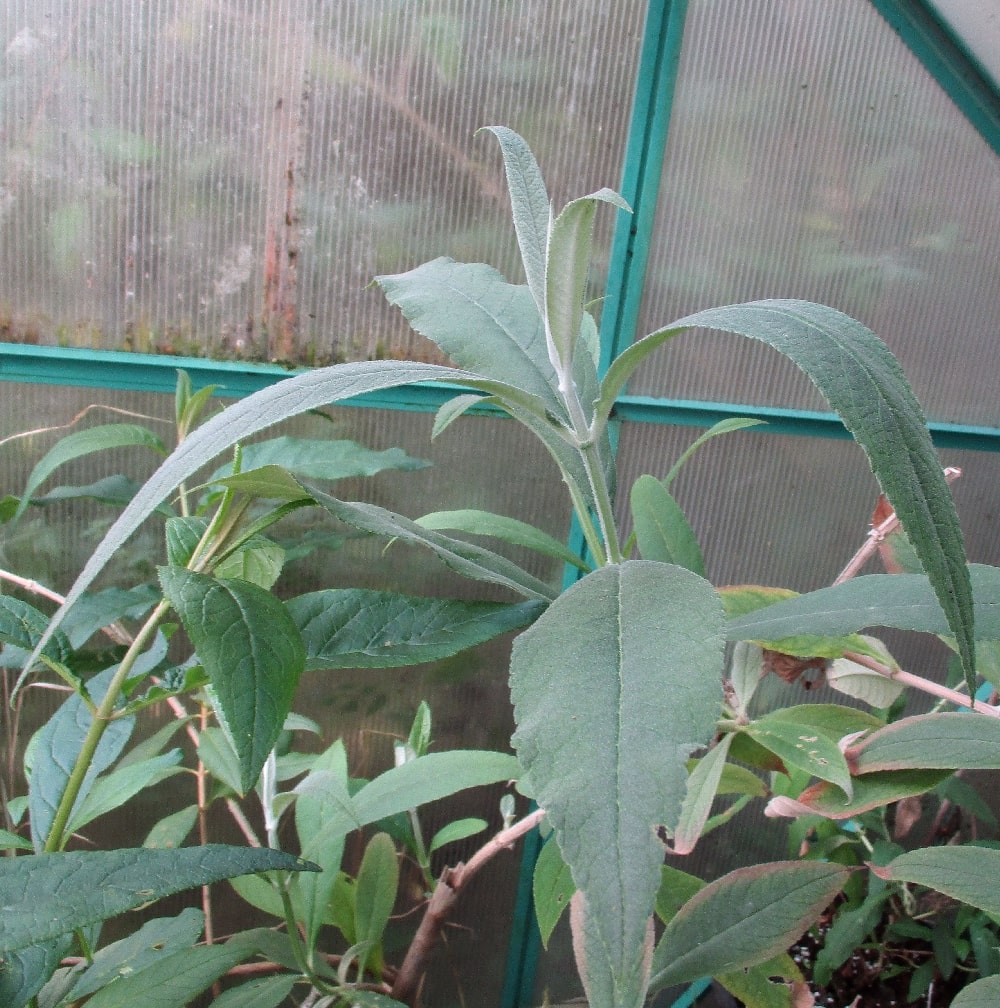
B. pterocaulis should be a form of B. forrestii.
Open full size image in a new window
Buddleja forrestii
type pterocaulis
Several species were sunk under B. forrestii by Leeuwenberg (1979) including B. limitanea W.W.Smith (see below) and B. pterocaulis A.B.Jackson (originally called B. longifolia Gagnep., which has caused some confusion). Plants labelled 'B. pterocaulis longifolia', which is not a legitimate name, are supposedly a form of B. forrestii. It would seem extant ex situ examples are derived from a specimen once grown at Borde Hill, West Sussex (see Marquand 1930 and Jackson 1935).
The name pterocaulis references the winged stems, although the wings of this form are no more conspicuous than any other form. No one I’ve contacted seems to remember seeing the flowers, reportedly a purple- or violet-colour. I have managed to persuade my pot-grown specimen to flower. Although the leaves and branchlets are somewhat more pubescent than average for the species, the flowers are absolutely typical - mostly glabrous ovary and exterior to corolla, stigma level with the stamens and funnel-shaped - and they have proved to be white rather than violet.
I've found another source for this type, and I'm hoping this second 'pterocaulis' will have the reported violet-hued flowers.
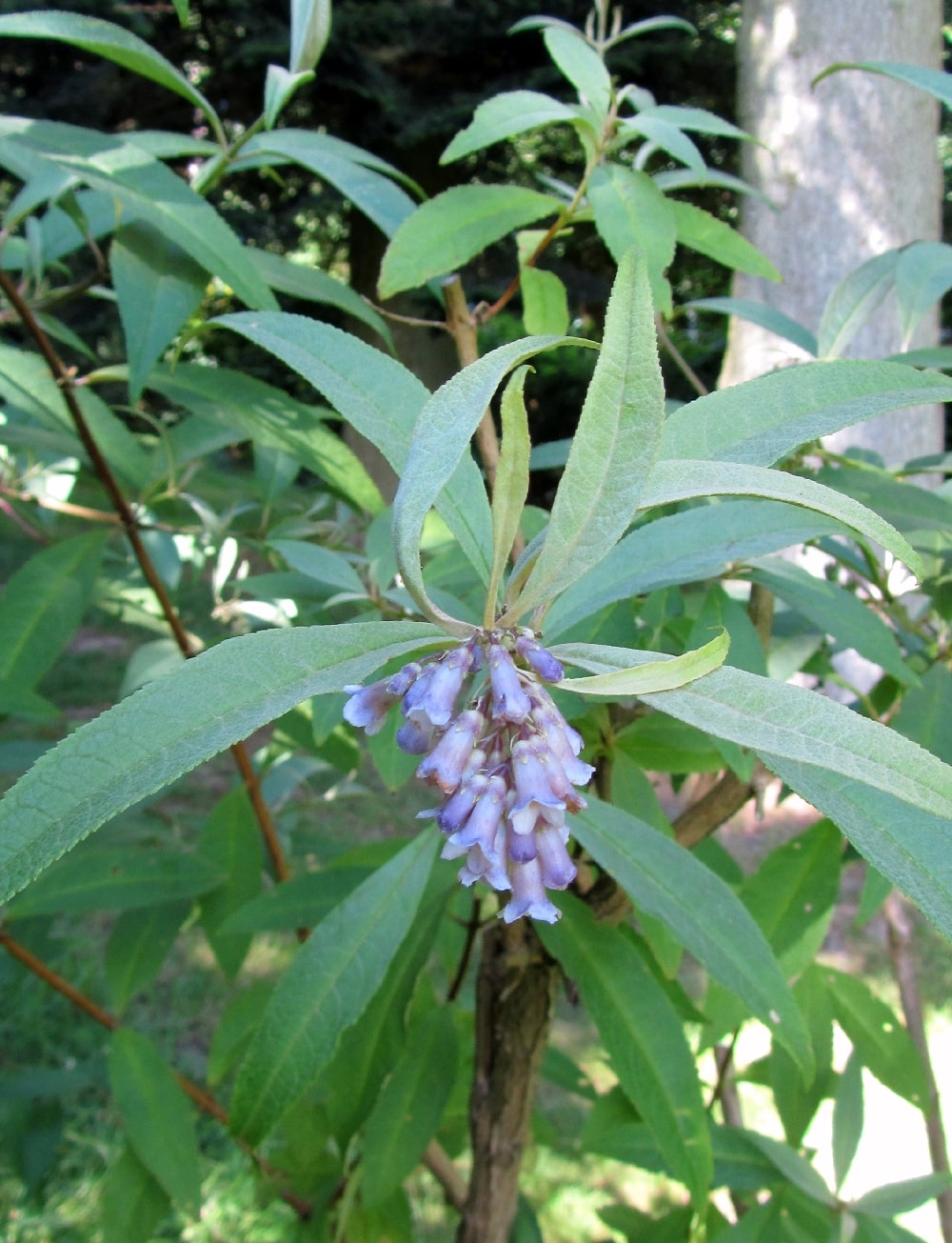
ACE 2522 is a Buddleja forrestii of the type previously described as B. limitanea.
Open full size image in a new window
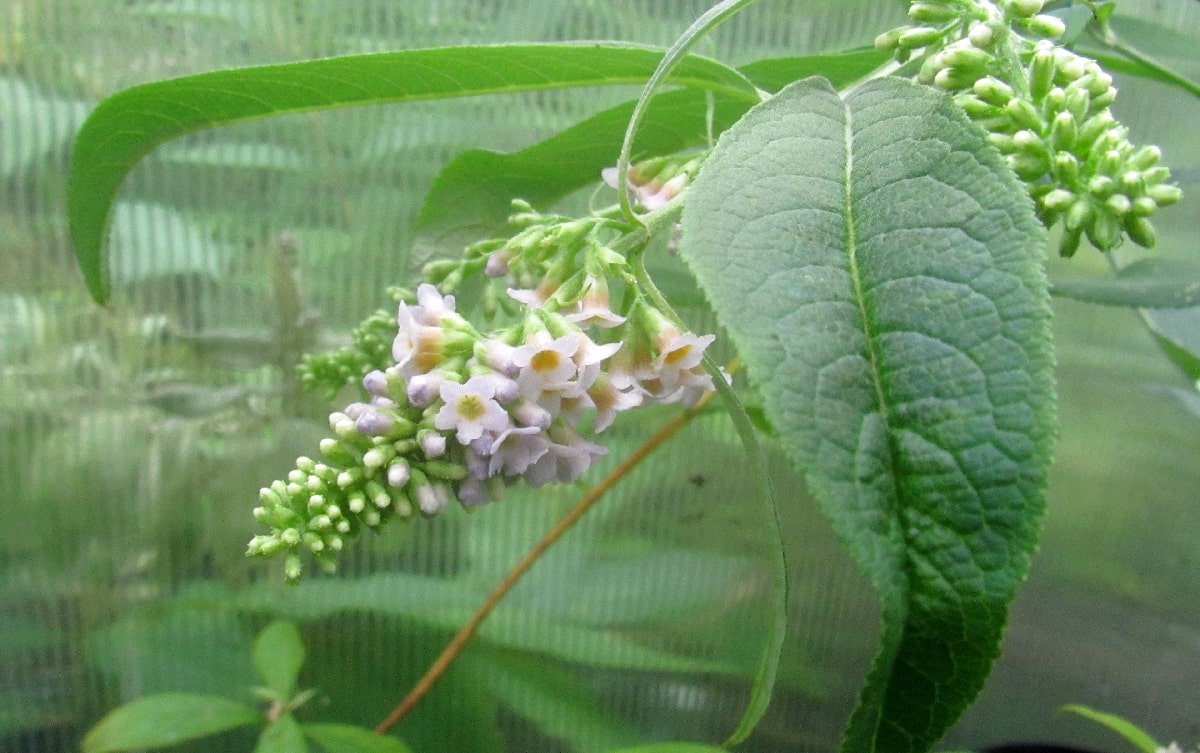
Buddleja forrestii BO 14-138 has delicate pink flowers
Open full size image in a new window
Buddleja forrestii
type limitanea
A Chinese Buddleja which was once treated as a species in its own right, but is now considered a smaller type of B. forrestii. However, it is still frequently labelled as B. limitanea in horticulture, so here it is described as a form, rather than a subspecies or variety. Typically, it has pendulous panicles of mauve-purple to white flowers that appear in mid- to late-summer and may continue to flower until well into the autumn. The individual flowers are larger than B. davidii and have the typical short, funnel-shape corolla of B. forrestii; they can be purple in bud, but often fade after they open. The leaves are usually smaller than the larger forms of B. forrestii, and sometimes slightly grey-felted. Less vigorous than other forms, it grows to about three metres height and spread. It’s quite hardy, but can be cut back hard in cold winters. If pruning is required, and it can become quite straggly, it should be done in early spring like B. davidii.
There are several different cultivars (or ‘collections’) around the UK. Buddleja sp. ACE 2522, collected by the Alpine Garden Society, KR 2737, collected by Keith Rushworth, and BO 14-138, collected by Bjørnar Olsen are all from the Cangshan in Yunnan, China.
There also are cultivars of unknown origin. One, which has lost its history, has been erroneously labelled as B. delavayi, a species totally unlike any B. forrestii. This plant is a very attractive form, with large individual flowers with a soft-lilac flush, and lighter green foliage. Reputedly less hardy than others, I’ve found it quite forgiving. See the Supplementary Gallery page.
There is also a plant labelled as B. limitanea, which is somewhat more ambiguous and whose origins are unknown. In most details, it looks much the same, except for the flowers: these are mauve-purple and have a long corolla tube; the flower parts also have a pubescence not common in forms of B. forrestii. I suspect this plant may be hybrid in origin, either natural or more likely raised ex situ. Just possibly, it is Buddleja X ‘Hotblackiana’, a hybrid of B. forrestii and B. davdii once listed by the RHS and now thought lost. The flower morphology is similar to a B. forrestii and B. davidii hybrid I raised myself. See the Supplementary Gallery page for more details.
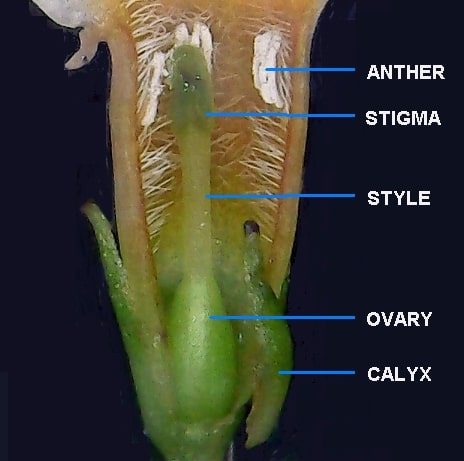
The flower of B. forrestii flares towards the mouth, has anthers level with stigma and the ovary is hairless.
Flower Morphology
Sometimes B. forrestii and B. macrostachya are difficult to tell apart, as the two species can be so similar. Gross features such as panicle form, foliage, stem shape and growth habit cannot be relied upon to reliably identify the species. Only close examination of the flowers can effectively distinguish them. As a general rule, the ovary, style and exterior of the corolla are glabrous (virtually hairless) in B. forrestii, whereas these parts are stellate-tomentose (with a covering of tangled hairs) in B. macrostachya. The corolla tube is short (6-9 mm), wider and flares towards the mouth; in B. macrostachya the tube is 9-14mm long and cylindrical. In both species, the almost sessile anthers are placed close to the mouth of the flower: level with the stigma in B. forrestii and somewhat above in B. macrostachya. The interior of the tube may be pilose (with longer, straight hairs).
Buddleja macrostachya Benth.
Synonymous species:
Buddleja cylindrostachya Kraenzlin;
Buddleja hancockii Kraenzlin;
Buddleja henryi Rehder & E.H.Wilson;
Buddleja henryi var. hancockii (Kraenzlin) C.Marquand;
Buddleja hookeri C.Marquand;
Buddleja hosseusiana Kraenzlin;
Buddleja martii Schmidt.
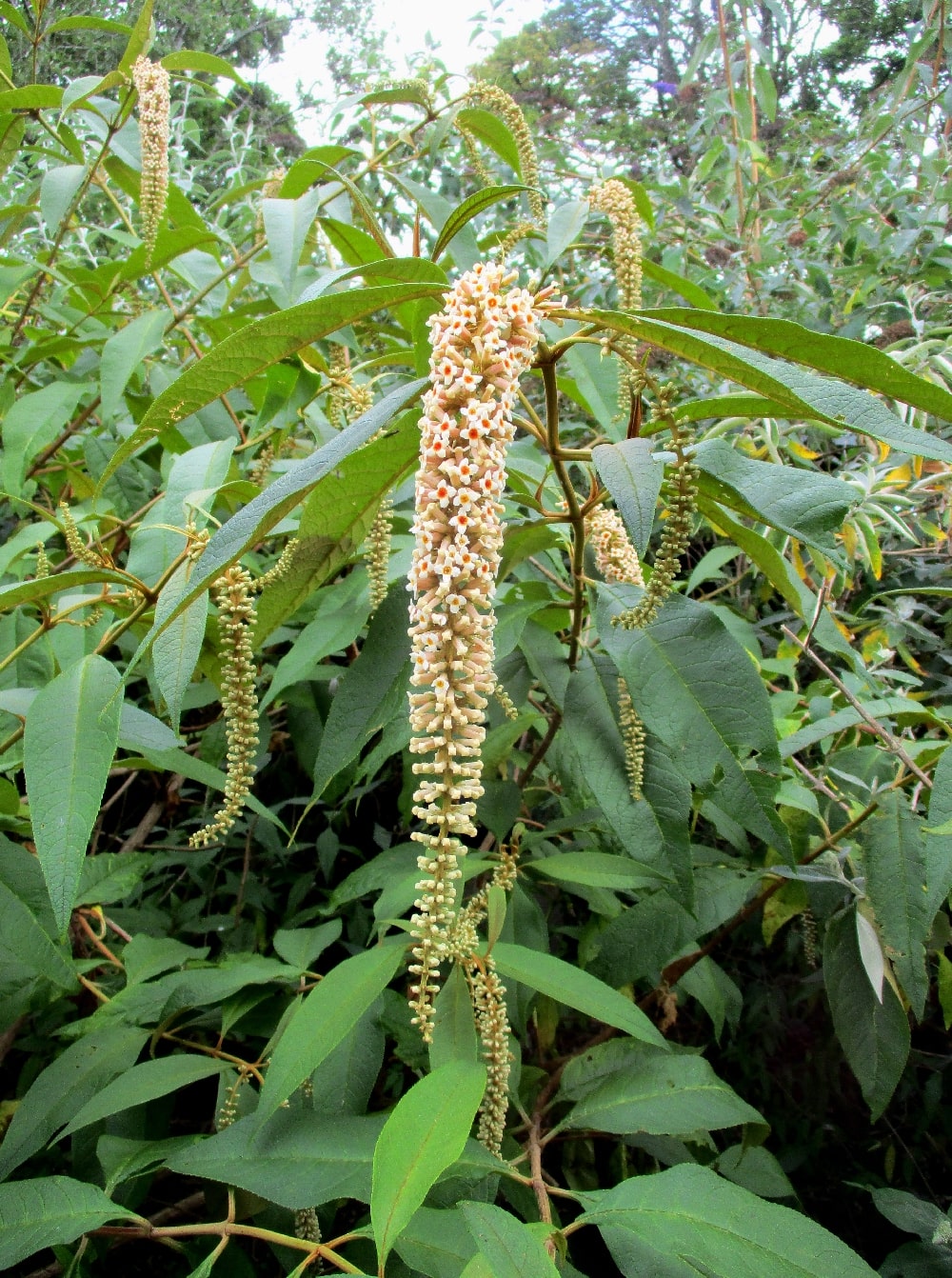
Buddleja macrostachya RF 040: this particular example shows how closely this species may resemble B. forrestii. Only close examination reveals its correct identifiction.
Open full size image in a new window
B. macrostachya is also a very variable species with a wide range across the Himalayan region and south-east Asia, and frequently co-existing with B. forrestii. Although sympatric, the two species do not appear to frequently hybridise. The flowers can be white through to wine-red, the panicles upright or pendulous, and the flowering time can vary from summer to mid-winter. This variation in form led the plant hunters of the late 19th and early 20th centuries to supposedly ‘discover’ a number of discrete species, although now it is generally accepted many of these can be reduced to synonyms; this species is no more, and probably less, divergent than in the familiar B. davidii. There is some suggestion B. macrostachya may still be undergoing a rapid evolution and divergence, although this does not suggest the various forms have diverged into separate species (Chen at al 2007).
Some members this species can be virtually indistinguishable from B. forrestii without close examination of the flowers. Others may be distinguishable by their more felted or glaucous leaves, although this is a far from reliable indicator. There are quite a few different plant collections around the UK in the horticultural trade and in botanical gardens.
One plant I’ve grown is, I believe, RF 040 from Arunachal Pradesh, north-east India, and is currently being mislabelled as 'B. forrestii'. It demonstrates how B. macrostachya can so closely resemble B. forrestii in all but the smallest details. This collection forms a large semi-deciduous shrub, with large leaves and rounded branchlets, both covered in an unusual coppery-brown tomentum. RF040 flowers in summer (around early August); the panicles are long, pendulous and many flowered, and loved by the bees. The colour is cream, but can appear slightly pale-pink in some lights. The most obvious features in determining this plant as B. macrostachya are the stellate-tomentose (with tangled hairs) exterior of the long, cylindrical corolla tube and the calyx. This has proved quite hardy (down to at least -5ºC) once established, although much lower than this and it will shed its leaves and suffer some die-back.
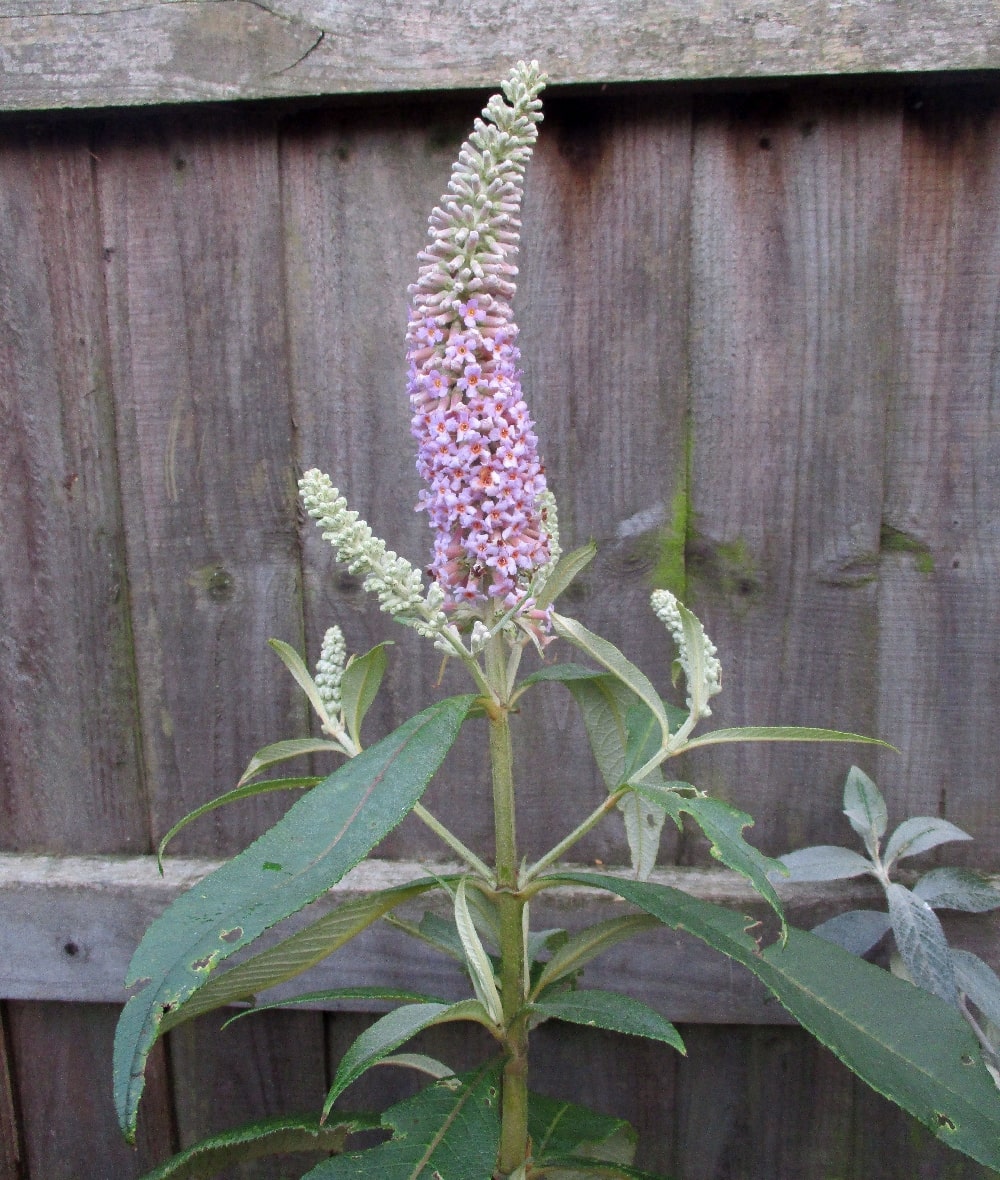
Buddleja macrostachya PAB 4198, a late flowering collection from India.
Open full size image in a new window
The species is quite variable with regards to flowering time, with some collections flowering much later in the year – in the autumn or even after mid-winter. As far as I can ascertain, this appears to be more common in southern populations; possibly it’s a strategy to avoid coinciding flowering with the monsoons and taking advantage of a longer growing season.
PAB 4198 is a collection by Paul Barney of Edulis Plants, originating from Shillong, (Meghalaya, India) and has fleshy pink flowers in upright panicles. It flowers very late in the season, about November. It needs both a good summer and a mild autumn for it to bloom well in the UK. In my garden, it's formed a small tree and is over four metres in height.
On casual examination, it appears very different to RF 040. However, the individual flower morphology is the same. The exterior of the corolla tube and the calyx has the same tomentose appearance, and the ovary and style (pistil) are practically identical. There is little doubt it is the same species as RF 040, and the change in phenology no more than a local adaptation.
See the Supplementary Gallery for other examples of this species in north-eastern India.
Two other interesting winter flowering forms are HWJ 602 and WWJ 12016, collected by Crûg Farm Plants in north Vietnam at the eastern extreme of the species' range.
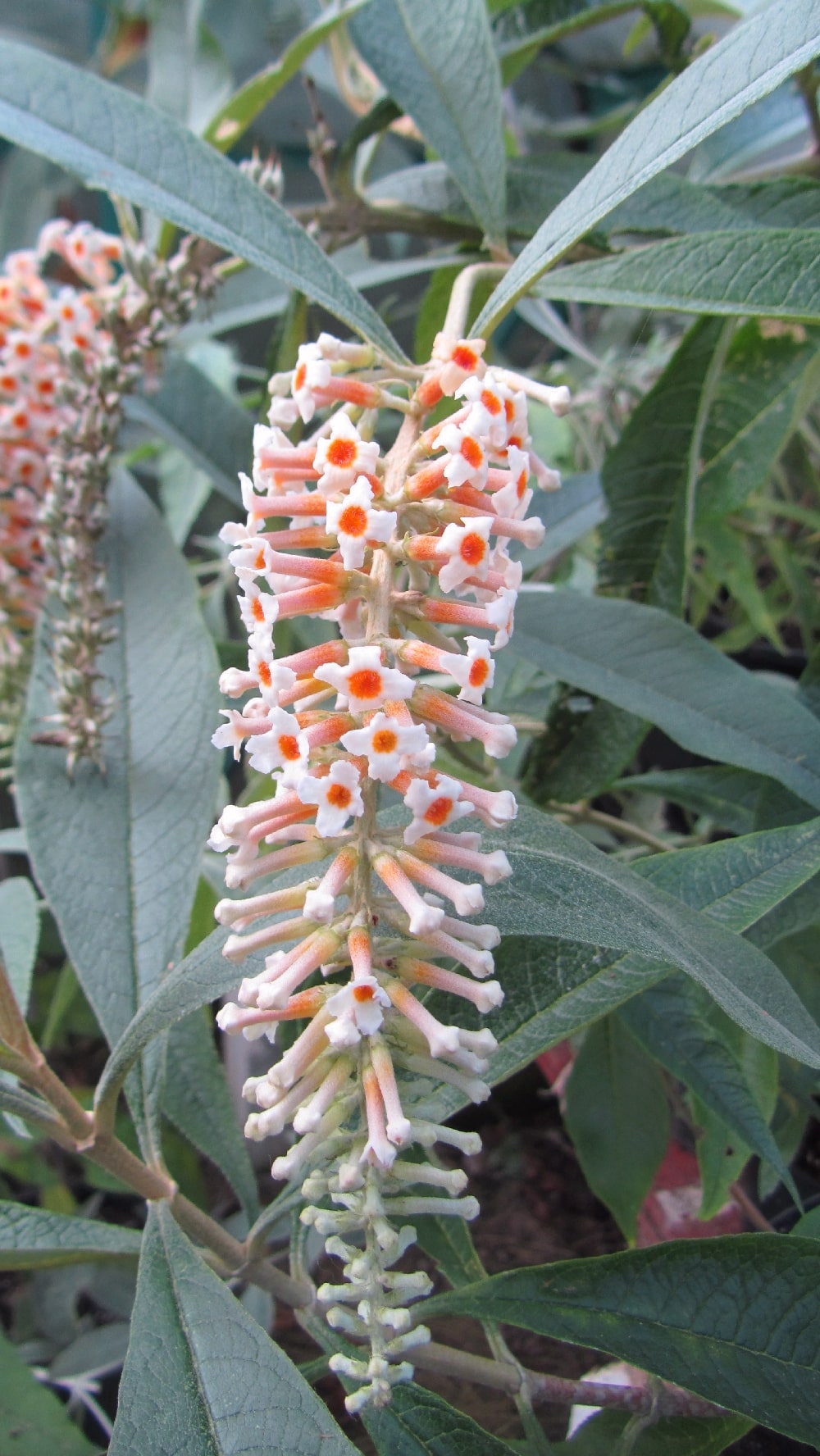
Buddleja sp. GWJ9286, recently given the name 'Sikkim Snow', ia actually a small form of Buddleja macrostachya
Open full size image in a new window
GWJ 9286 was collected in the Lachen Valley, Sikkim (northern India) by Crûg Farm Plants, North Wales. It's been labelled variously as B. paniculata, species nova and currently as B. myriantha v. alba 'Sikkim Snow'.
However, I have positively identified the collection as a form of B. macrostachya, although GWJ 9286 is atypical for the species, being smaller overall: about 2 metres height and spread and with more delicate silvery foliage. The flowers themselves conform precisely to the botanical descriptions of B. macrostachya, although the flower-panicle is more open (interrupted) that others of this species (see Leeuwenberg 1979). They are very different to the flowers of B. myriantha, a species more akin to B. davidii and B. albiflora.
Going back to C.V.B. Marquand's 1930 Revision of the Old World Species of Buddleja, one previously recognised species was Buddleja hookeri, now synonymous with B. macrostachya. Marquand's description of B. hookeri is remarkably similar to GWJ 9286 in many respects - small calyx, tomentose ovary and corolla tube, lax flower panicle and subterete (rounded) stems. Moreover, the original report cites the Lachen Valley, Sikkim as the location of the B. hookeri holotype, the same as GWJ 9286. Leeuwenberg also notes the B. hookeri type as having interrupted panicles. The literature provides strong evidence for GWJ 9286 being this form of B. macrostachya.
Having grown the plant for a few years, I would recommend it as by far the best form of B. macrostachya for the average garden with its fine foliage, restrained habit, and attractive blooms, which are strongly scented as an added bonus.
I’ve also had the opportunity to attempt different pollinations and to grow its progeny. Unlike many of the B. forrestii plants, I’ve found B. macrostachya plants reluctant to hybridise. GWJ 9286 has crossed quite readily only with RF 040; the resulting reciprocal seedlings are intermediate between the types and immediately recognisable as B. macrostachya, leaving me in no doubt as to my identification. See the Supplementary Gallery to view the seedlings.
SBEC 360 was collected by Roy Lancaster in 1981 on the Sino British Expedition to Cangshan (SBEC), Yunnan, China. Allegedly, his personal specimen was so vigorous it had to be removed before it damaged his house. It's grows into a very large shrub that flowers in the summer months, and is likely self-fertile. Identification as B. macrostachya is less certain than the others mentioned, as the ovary is almost glabrous, but the corolla tube is cylindrical and somewhat tomentose, so I think the designation is probably correct. SBEC 360 has been mistakenly labelled as B. x alata in some gardens.
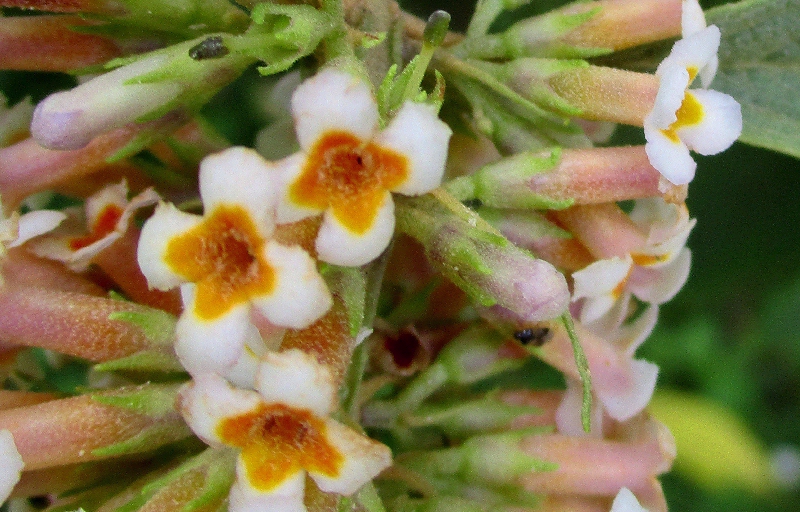
The flowers of SBEC 360 have shorter corolla tubes with sparser tomentum than average for the species, so the identification as B. macrostachya is less certain.
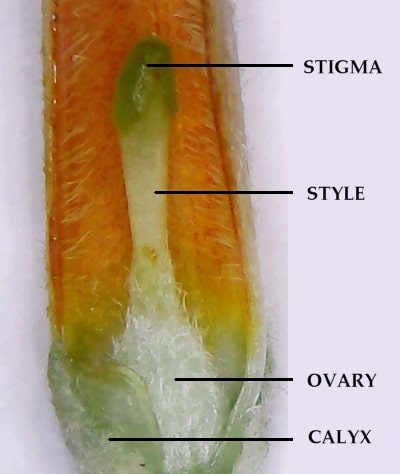
The corolla tube of B. macrostachya is cylindrical, and the ovary and calyx are covered in tangled hairs.
Flower Morphology
Buddleja macrostachya is most easily distinguished from the similar B. forrestii by dissecting the flowers.A B. macrostachya RF 040 flower has been cut open to reveal the pistil and ovary. Note that the ovary (and later the seed capsule) is covered in tangled hairs (stellate-tomentose) and how the base of the style is also hairy. The interior of the corolla tube has numerous hairs (villose) down to level with the ovary and the calyx is tomentose (covered in hairs). In comparison, the flower of B. forrestii lacks this tomentum: the ovary, calyx and exterior of the corolla tube is glabrous or with very few hairs; additionally, the interior of the corolla tube usually has hairs increasing towards the throat. In B. macrostachya, the stamens are in the throat of the flower and held above the stigma, whereas in B. forrestii the stamens are typically level or almost level with the stigma.
Hybrids
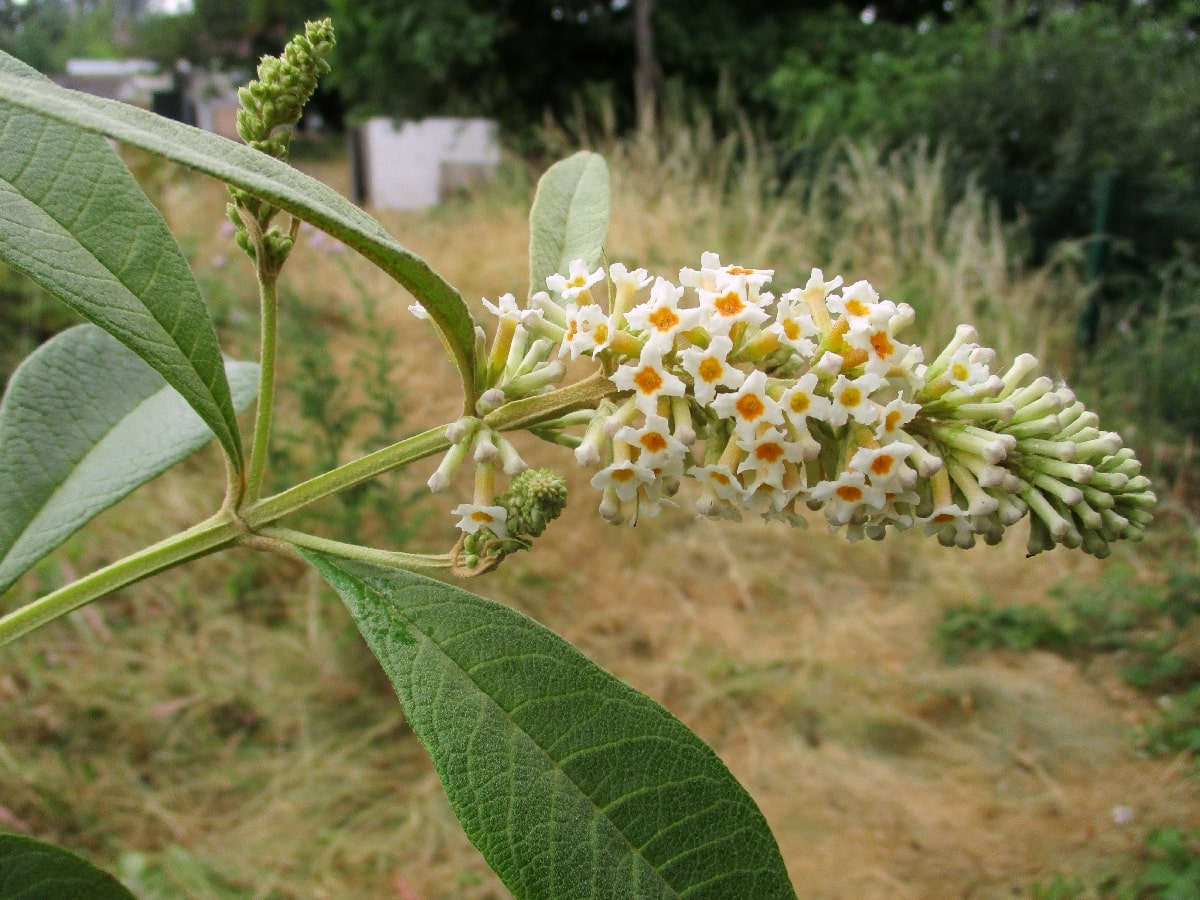
This B. forrestii x B. macrostachya hybrid could be either species from a distance.
Open full size image in a new window
A B. forrestii x B. macrostachya was reported by Leeuwenberg (1979). Possibly, because the two species can be easily confused, this was one or other of the species rather than an actual hybrid. B. x griffithi Marquand has been both reported as a variety of B. macrostachya and as a hybrid of B. macrostachya and B. candida. More details here.
In my garden, I have found B. macrostachya very reluctant to cross with other species, whereas B. forrestii will hybridise with several other species. I have successfully produced only one B. forrestii x B. macrostachya hybrid, using the white flowered B. forrestii shown at the top of the page as the seed parent, and using B. macrostachya RF 040 as the pollen donor. The plant is a perfect intermediate. Dissection of a flower shows the stigma is only slightly below the level of the stamens, whereas in B. macrostachya the stigma is typically much lower due to the long corolla tube, and in B. forrestii the stigma is practically level with the stamens because the tube is relatively short. The tube length itself is intermediate between the parent species.
It is interesting to speculate whether the large number B. forrestii and B. macrostachya synonyms may be due in part to the collecting and describing of naturally occurring hybrids and intermediates by the plant-hunters, with any taxonomically ambiguous plant receiving a new epithet. It also can't be discounted that hybridisation plays a significant part in the infraspecific diversity of these and other Buddleja species.
Key for distinguishing the species
Both species are highly variable, and features will vary across each species. The feature most useful for a correct identification is the individual flower, with the shape and indumentum of the corolla tube being the most consistent and reliable difference between the species; when considering to which species a specimen should be assigned, this feature should be the most heavily weighted.
The seeds capsules of B. macrostachya remain
covered in hairs and the dried pistil can be persistent.
Open full size image in a new window
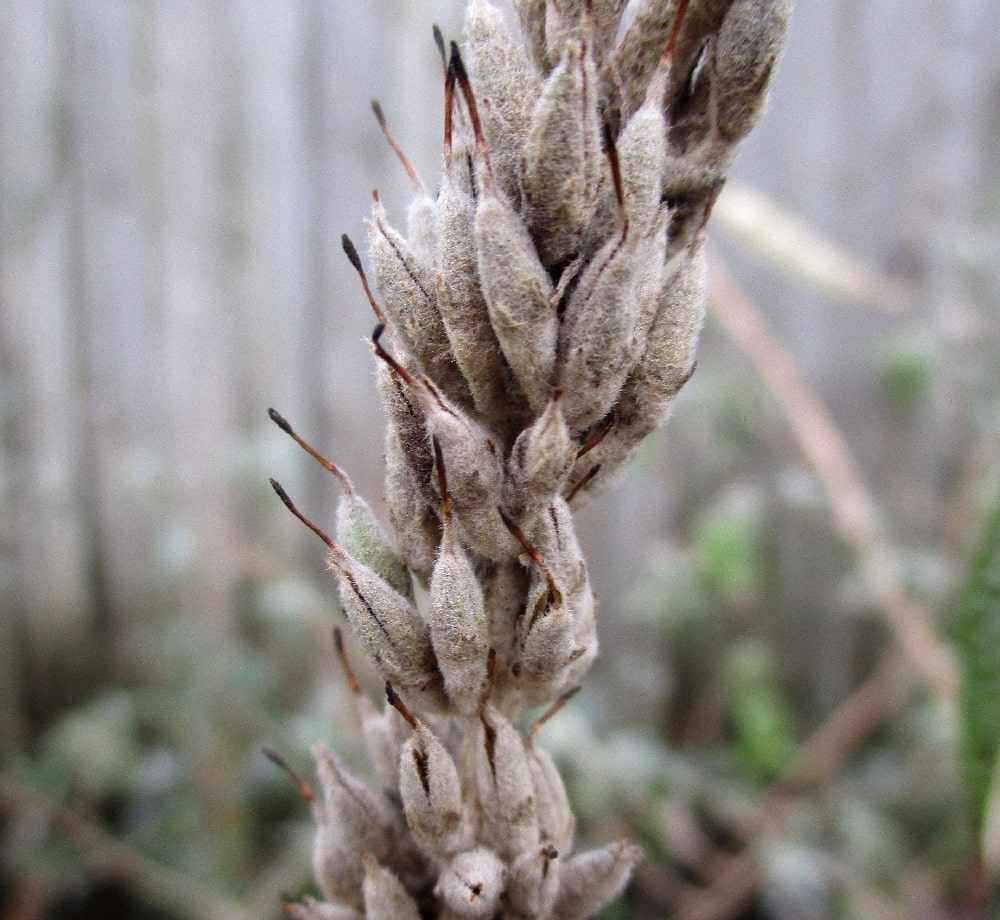
| B. forrestii | B. macrostachya | |
| Stems | Branchlets four-angled, winged; pubescent at first, later becoming glabrescent. | Branchlets terete to four-angled, sometimes narrowly winged, white or tan indumentum. |
| Leaves | Leaf underside only thinly tomentose. | Leaf underside densely stellate-tomentose. |
| Corolla tube. | 6-9mm long, funnel-shaped, exterior glabrous or almost glabrous. | 9-14mm long, cylindrical, exterior tomentulose to densely stellate-tomentose. |
| Stamens | Inserted at the mouth, level or almost level with the stigma | Inserted at or near the mouth, somewhat above the stigma. |
| Ovary and base of style | Glabrous to almost glabrous with few hairs, or occasionally loosely tomentose on upper half only. | Lightly pubescent to densely stellate-tomentose. |
| Seed capsule | Glabrous or glabrescent, end rounded without persistent pistil. | Retaining tomentum, end pointed with persistent dried pistil. |
Acknowledgments
For plants, photos and conversations, my thanks to:
Paul Barney - Edulis Plants
Peter Brownless - Royal Botanic Gardens, Edinburgh
Andrew Bullock - The Lavender Garden
Nick Lock- Nick Lock Plants
Peter Moore -
Longstock Park
Nursery
Bjørnar Olsen - Chinese Alpines
Bleddyn Wynn-Jones - Crûg Farm Plants
References
Chen G., Sun W-B., Sun H. (2007) Ploidy variation in Buddleja L. (Buddlejaceae) in the Sino-Himalayan region and its biogeographical implications. Botanical Journal of the Linnean Society 154:305-312.
A.B.Jackson (1935) Buddleja pterocaulis in Journ. Bot. 73:81.
Selected pages from A.J.M. Leeuwenberg (1979) The Loganiaceae of Africa XVIII: Buddleja - Revision of the African and Asian Species: B. forrestii pp124-127; B. macrostachya pp133-136.
Selected entries from Flora of China (1996). 7. BUDDLEJA Linnaeus. 15: 329–337.
C.V.B. Marquand (1930) Revision of the Old World Species of Buddleja. Bulletin of Miscellaneous Information No.5 pp177-208. Royal Botanic Gardens, Kew.
Email:
buddlejagarden@gmail.com
© The Buddleja Garden 2011-2024.
